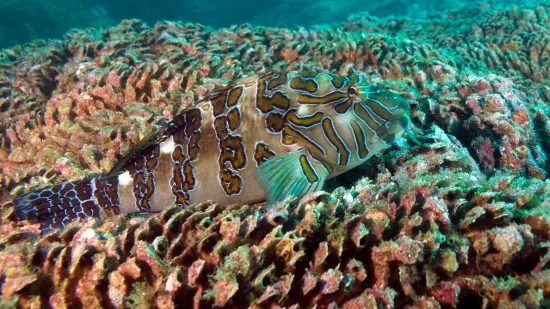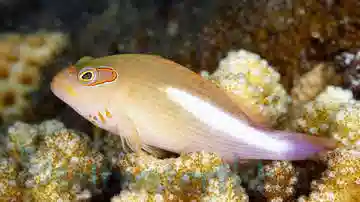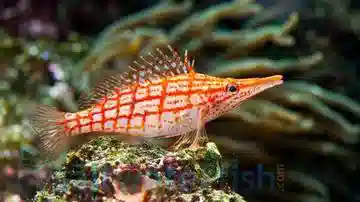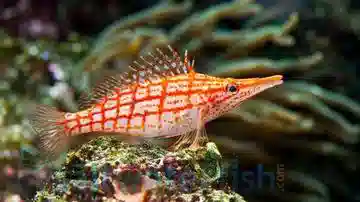Longnose Hawkfish - South Asia
Oxycirrhites typus
(0 Reviews)
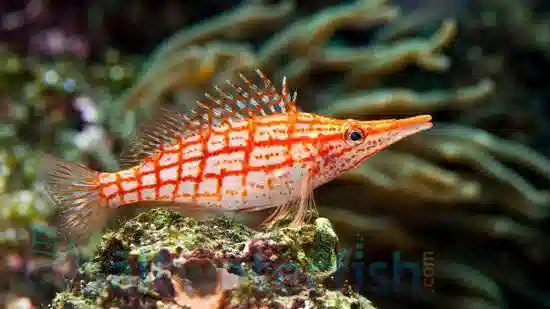
Longnose Hawkfish - South Asia
Oxycirrhites typus
(0 Reviews)
{{ item.name }}
Size: {{ item.extra_field_3 }}
${{ getFormattedPrice(item.saleprice) }} ${{ getFormattedPrice(item.price) }}
To join the waiting list, click here
Free Shipping
With
$199.00
or more in Marine Life.
More details...
Longnose Hawkfish - South Asia Care Facts
| Size: | 3-3.5 inches |
|---|---|
| Care Level: | Easy |
| Temperament: | Bold |
| Reef Safe: | Monitor |
| Diet: | Carnivore |
| Origin: | Indian Ocean |
| Acclimation Time: | 3+ hours |
| Coral Safe: | Yes |
| Invertebrate Safe: | Monitor |
| Minimum Tank Size: | 30 gallons |
Keeping the Longnose Hawkfish (Oxycirrhites typus) in Your Saltwater Aquarium
The Longnose Hawkfish, scientifically known as Oxycirrhites typus, is a captivating and unique marine species that can be a valuable addition to your saltwater aquarium. In this comprehensive guide, we will provide essential information on successfully caring for Longnose Hawkfish, including insights into their habitat, reef compatibility, size, lifespan, dietary needs in captivity, availability through aquaculture, compatibility with other marine species, sexual dimorphism, changes in coloration from juvenile to adult stages, temperament, specific tank requirements, and precise water conditions. We will also list common names for this species and explain why acquiring Longnose Hawkfish from Saltwaterfish.com is a wise choice.
Habitat and Natural Range of Longnose Hawkfish
Longnose Hawkfish can be found in the Pacific Ocean, where they inhabit reef areas and are often seen perching on rocks, corals, or other elevated structures. They prefer rocky substrates with plenty of hiding places to take refuge.
Reef Compatibility of Longnose Hawkfish
These hawkfish are considered reef-safe, making them suitable for reef aquariums. They tend not to bother corals or invertebrates, but it is essential to maintain a peaceful environment and ensure that tank mates are compatible with the Longnose Hawkfish.
Size and Lifespan of Longnose Hawkfish
The Longnose Hawkfish typically grows to an average size of around 4 to 5 inches (10.16 to 12.7 centimeters). In captivity, they can have a lifespan of up to 5 to 7 years or even longer with proper care, providing a lasting presence in your aquarium.
Diet in Captivity for Longnose Hawkfish
Longnose Hawkfish are opportunistic predators in the wild that feed on small crustaceans, zooplankton, and small fish. In captivity, it is crucial to provide them with a well-balanced diet to ensure their health and vitality:
- High-Quality Pellet and Flake Foods: These hawkfish can be trained to accept high-quality marine pellets or flakes, which should be a staple in their diet.
- Frozen and Live Foods: Supplement their diet with various live or frozen foods, including brine shrimp, mysis shrimp, and chopped seafood. This replicates their natural feeding habits and provides essential nutrients.
- Occasional Small Fish: Longnose Hawkfish may also consume small fish, but this behavior is less common in captivity and typically occurs in larger specimens.
Aquaculture and Availability of Longnose Hawkfish
While Longnose Hawkfish are not as commonly aquacultured as other marine species, they are occasionally available through reputable suppliers like Saltwaterfish.com. Acquiring aquacultured specimens ensures that they are well-suited to the aquarium environment.
Compatibility with Other Fish and Invertebrates for Longnose Hawkfish
Longnose Hawkfish are generally peaceful and can coexist with various compatible tank mates. However, specific considerations should be kept in mind when choosing suitable companions:
- Compatible Tank Mates: Opt for less aggressive or overly territorial fish species, as Longnose Hawkfish prefer a more tranquil environment.
- Invertebrates: While Longnose Hawkfish are considered reef-safe, they may sometimes harass smaller, slow-moving invertebrates. Observing their behavior and ensuring the compatibility of invertebrates in the tank is advisable.
Sexual Dimorphism of Longnose Hawkfish
Longnose Hawkfish do not exhibit sexual dimorphism, meaning that males and females have similar external appearances, making it challenging to differentiate between the sexes based on physical characteristics.
Juvenile to Adult Coloration Changes in Longnose Hawkfish
Their coloration remains relatively consistent as Longnose Hawkfish mature from juvenile to adulthood. They typically display a striking, eye-catching appearance, with vivid red or orange bodies and elongated snouts.
Temperament of Longnose Hawkfish
Longnose Hawkfish are known for their distinctive behavior, often perching on rocks, corals, or elevated structures. They use their pectoral fins to stabilize themselves while scanning the aquarium for prey. These hawkfish are not particularly aggressive but may display territorial behavior if other hawkfish or similar species are introduced to the same tank. They are known for their curious and inquisitive nature, making them engaging additions to your aquarium.
Tank Requirements for Longnose Hawkfish
To create a suitable habitat for Longnose Hawkfish and ensure their well-being, consider the following tank requirements:
- Minimum Aquarium Size: A minimum tank size of 30 gallons is recommended to provide enough space for these hawkfish to establish their territories and swim freely.
- Aquascape: Create a well-structured aquascape with plenty of hiding spots, live rock, and elevated structures for perching. The presence of caves and overhangs can also make the environment more dynamic and engaging.
- Tank Lid: These hawkfish are known to jump, so a secure lid is essential to prevent accidental escapes.
Water Conditions for Longnose Hawkfish
Maintaining precise water conditions is vital for the health and longevity of Longnose Hawkfish:
- pH Level: Keep the pH level within 8.1 to 8.4 to maintain a stable and healthy aquatic environment.
- Salinity: Maintain stable salinity levels at approximately 1.025 to ensure the well-being of these marine fish.
- Water Temperature: Maintain a water temperature range of 72°F to 78°F (22°C to 26°C).
- Water Flow: Longnose Hawkfish prefer low to moderate water flow within the tank to swim comfortably and hunt efficiently.
Common Names of Longnose Hawkfish
The Longnose Hawkfish is also known by common names such as the Longnose Hawk, Pixy Hawkfish, and Elegant Firefish.
Why Choose the Longnose Hawkfish from Saltwaterfish.com?
Acquiring Longnose Hawkfish from Saltwaterfish.com offers several notable advantages:
- Healthy Specimens: Saltwaterfish.com is committed to providing customers with robust and well-acclimated Longnose Hawkfish, ensuring their readiness for aquarium life and contributing to their long-term well-being.
- Responsible Sourcing: By acquiring these hawkfish from Saltwaterfish.com, you support responsible sourcing and ethical collection practices for marine species.
- Expert Guidance: Saltwaterfish.com offers expert guidance and support to help you provide the best care for your Longnose Hawkfish in your saltwater aquarium.
In conclusion, the Longnose Hawkfish (Oxycirrhites typus) is a captivating and peaceful addition to your saltwater aquarium. Admired for their unique appearance and engaging behavior, they can make a delightful choice for marine enthusiasts. Choosing Longnose Hawkfish from Saltwaterfish.com ensures access to healthy specimens and expert advice for their successful care in your aquarium.
Currently Longnose Hawkfish - South Asia does not have any reviews.


